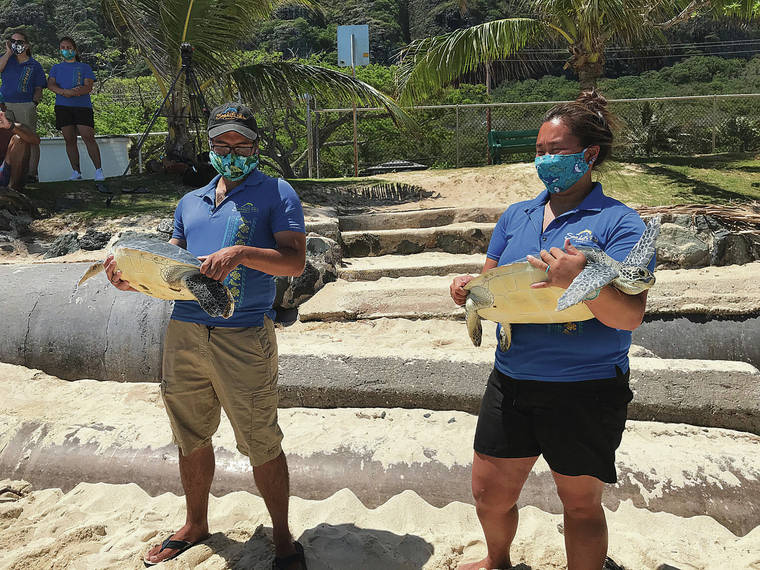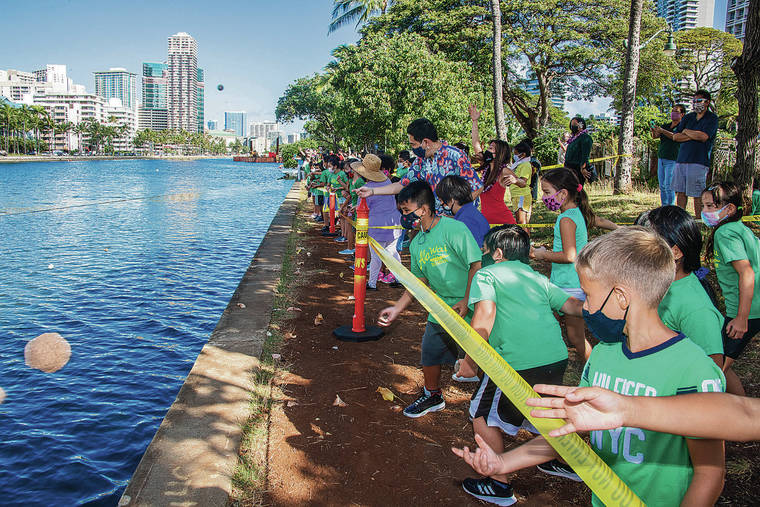Earth Day celebrated in Hawaii with honu and special mud balls


MINDY PENNYBACKER / MPENNYBACKER@STARADVERTISER.COM
Sea Life Park employees Freddie Velasquez, left, and Rachel Pierce held young honu Thursday morning at Kaiona Beach Park for a Hawaiian blessing before they were set free.

CRAIG T. KOJIMA / CKOJIMA@STARADVERTISER.COM
In an effort to clean up the Ala Wai, Ala Wai Elementary School students tossed their handmade “genki balls” into the canal Thursday. Aliamanu Middle School students also made and joined in tossing the probiotic bacteria-laden mud balls.



On Thursday, Earth Day morning, two planet-healing, aquatic events took place in very different areas of Oahu: the clear blue sea at Waimanalo Beach and the muddy brown waters of the Ala Wai Canal.
Each water body received healthy, restorative gifts.
At Waimanalo’s Kaiona Beach Park, a pair of calm, clear-eyed young honu, about 2 feet long with shining, immaculate black shells, arrived in a plastic crate to be released into the wild.
On the beach the 4-year-old green sea turtles flapped their flippers as they were held in the arms of caretakers while Pahonu Coleman, 15, sang a brief pule in a sweet tenor voice, “to offer a blessing to the honu, wish them luck and hope to see them one day.”
Then the pair, which had been bred and raised at Sea Life Park in a program to restore populations of the endangered species, were set down in the dry sand at the top of the beach to find their way to the sea.
One turtle crawled directly into the transparent shallows and launched itself, looking back once at the beach before swimming north, against the current, in the direction of the historic Pahonu turtle pond whose formerly collapsed stone walls Waimanalo Limu Hui has been rebuilding as it replants native limu, the honu’s preferred food, throughout Waimanalo Bay, Kailua Bay and beyond.
Don't miss out on what's happening!
Stay in touch with breaking news, as it happens, conveniently in your email inbox. It's FREE!
“We started in 2017 because the kupuna were alarmed the limu had nearly disappeared when it used to be so abundant, lying in piles on the beach,” said Ikaika Rogerson, hui president. “There’s a wind in Waimanalo named Li puu puu because it would bring the scent of limu inland.”
As the limu vanished due to water pollution, reef erosion and competition from invasive species, so did native turtles and fish that depend on it for sustenance, Rogerson said. The hui has been partnering with Sea Life Park, which provides it with native limu that its scientists cultivate in tanks.
In return, he added, as turtles and fish eat the limu, they excrete spores that flow down-current, seeding the plants along the coast.
Limu and honu growing go hand in hand, agreed Valerie King, the park’s general manager, who estimated the park’s program has released close to 17,000 turtles, mostly tiny hatchlings but sometimes adolescents like Thursday’s pair, the other of which got off to a shaky start, heading for the water, then reversing up the beach before it eventually turned makai and crawled into the sea as the small audience of humans heaved signs of relief.
Also on Thursday morning, students at Ala Wai Elementary School were tossing baseball-size “genki balls” into the Ala Wai Canal in a project to clean up its murky waters and make them swimmable and fishable in seven years, according to technical adviser Hiromichi Nago, owner of Effective Microorganisms Hawaii.
The children had made the balls by hand, Nago said, using clay soil from garden supply stores mixed with rice bran, molasses, lactic acid, yeast and probiotic bacteria.
The bacteria digest hydrogen sulfite and ammonia, “all that stinky stuff that runs off from streams into the canal — sewage, pet waste — it’s the same bacteria used in ‘bokashi’ buckets to compost animal matter,” he said.
The genki ball, he said, are heavy and sink to the bottom, where the up to 6 billion “friendly bacteria” in each ball start consuming filth.
Since November 2019, he added, students at Ala Wai Elementary School and Jefferson Elementary School have thrown 2,300 genki balls into the canal.
“Jefferson Elementary is at the very stagnant end of the canal, but a few weeks after the balls went in, we could see sand on the bottom,” Nago said, “and on the Ala Wai Elementary side, 10 inches of thick sludge were digested so you could see the rocks.”
He added that students and teachers at both schools are monitoring the ecosystem restoration with the help of the state Department of Health Clean Water Branch, which measures levels of the fecal indicator bacteria enterococcus in Hawaii waters.
“In the first year the canal by Jefferson School had enterococcus levels of 690 per milliliter, which dropped down to 190 per milliliter,” Nago said, adding that small fish could now be seen swimming in what had been a dead zone.
“If we make and throw the genki balls, maybe in the future there might be new creatures in the Ala Wai Canal we can learn about,” said Ala Wai Elementary student Emma Pastore-Braden in a school video of the event.
“Through these kinds of engaging projects, we want to teach children to be proactive with problem-solving and making things better for everyone,” said Michelle DeBusca, principal of the school.



